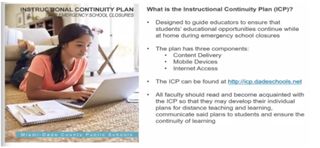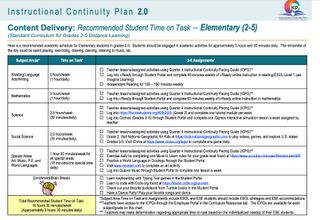As any educator knows, being prepared is critical, be it creating lesson plans, vetting resources, or even studying for tests. And that preparation extends to managing learning environments and ensuring instruction.
Miami-Dade County Schools is the nation’s fourth-largest district, serving an extremely diverse population of 348,000 learners and supporting more than 20,000 teachers. In 2012, the district passed a major referendum called “Digital Convergence” in an effort to provide more than 200,000 devices to teachers and students.
With so many learners, educators, and devices, maintaining instruction during remote learning was an enormous challenge.
In her presentation during Tech & Learning’s recent “Future-Proofing Your District” virtual conference, the district’s Chief Academic Officer Marie Izquierdo (@miamiCAO) shared how the district developed new teaching strategies in response to the crisis.
[embedded content]Curate and Utilize Existing Assets
Thanks to the Digital Convergence program, many teachers across the district had already developed best practices around certain tools and blended learning prior to the pandemic. The district goal was to maintain a “rigidly flexible” approach to the use of certain instructional edtech tools as it was not the time to force all teachers onto unknown platforms.
One of the first things done to support continuity was to curate and evaluate any and all existing digital assets. Looking at software license usage and usefulness, tools were sorted based on value in asynchronous and synchronous environments. Tools that the district had invested in that were not showing high usage was a concern. Do you continue to pay for these tools if they aren’t being used? Or if you know these platforms are valuable for instruction, do you invest more time for training?
District leaders opted for the latter, dedicating two school days for more than 40 live and on-demand professional development webinars for teachers. Many of these training sessions were created in partnership with platform partners while others featured teachers who were already demonstrating optimal online instructional strategies.

A Personalized Plan with Common Messaging
Now that all staff were remote, a new challenge arose in terms of how to create consistent messaging to all 20,000+ staff in terms of instructional expectations and delivery. Leaders worked with those teachers in the field who showed some early successes to crowd-source a checklist for all staff, which was then shared via powerpoint presentation so that all staff got the same message.
As a result, they were able to publish a set of instructions and readiness checklists:
Checklists for teachers
- Setting up classes
- Setting up online communication
- Communicating effectively and consistently
Checklists for administrators
- Support the current Instructional Continuity Plan (ICP)
- Make sure families complete mobile device surveys
- Hold emergency faculty meetings
- Coordinate the distribution of devices to students
- Support our most fragile learners (ELL, lower 25%, Low-SES, etc.)
- Maintain consistent communication
Building the Plane as You Fly It
The district already had an ICP, but when the pandemic occurred, leaders realized that plan was only a stop-gap. As they gathered feedback from the first few weeks of remote learning, they knew they needed to pivot. On April 3, just three weeks after the shutdown, they published their ICP 2.0, a guide built for all involved parties to encourage best practices of remote learning.
As the increase of screen time at home became an issue, “Time on Task” cards were built in throughout the guide (see sample below). These cards provide parents, students, and teachers with an overview of expectations for content and instruction. Developing activities for mental wellness checks and curriculum are embedded throughout these task cards.
The 4th-quarter curriculum was also compressed to make sure that certain key standards were covered during the time away from the classroom.

Within the plan, three different methods for instructional delivery are outlined:
- Teacher-directed
- Teacher-assigned
- Hybrid
Building Instructional Continuity Plan Guides (ICPGs) at least two weeks ahead of time kept teachers in the loop as to where they should be heading while creating a space to adapt and adjust, depending on learner needs.
“In many ways, we were building the plane as we fly it,” said Izquierdo.
Resources

